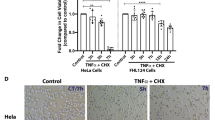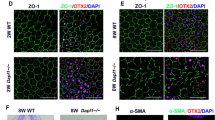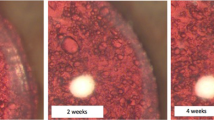Abstract
Posterior capsule opacification (PCO) is a common complication of cataract surgery. Using adenovirus(Ad)-mediated gene transfer, we overexpressed the proapoptotic molecules p53, procaspase 3, Bax, and TRAIL to induce therapeutic programmed cell death of residual lens cells to prevent PCO. Overexpressed TRAIL did not induce apoptosis in cultured rabbit lens cells or in human lens cells. Overexpressed p53 induced apoptosis of lens cells in vitro and ex vivo, but was unable to prevent PCO in vivo. Overexpressed procaspase 3 was associated with engagement of many components of the apoptotic pathway, including cleavage of intracellular caspase targets such as PARP and inter-nucleosome DNA fragmentation. Even when only slightly overexpressed, Bax caused apoptosis of transduced rabbit and human lens cells by engaging the mitochondrial pathway, including catalytic activation of the caspases. A single in vivo injection of Ad vectors expressing either Bax or procaspase 3 into the capsular bag at the end of phacoemulsification prevented PCO in rabbits. These experiments show that Ad-mediated Bax or procaspase 3 overexpression is capable of inducing therapeutic programmed cell death in vitro and in vivo in residual lens cells and preventing PCO in a rabbit model of PCO. Manipulation of proapoptotic molecule expression could be a novel gene therapy approach for prevention of PCO.
This is a preview of subscription content, access via your institution
Access options
Subscribe to this journal
Receive 12 print issues and online access
$259.00 per year
only $21.58 per issue
Buy this article
- Purchase on Springer Link
- Instant access to full article PDF
Prices may be subject to local taxes which are calculated during checkout




Similar content being viewed by others
Abbreviations
- HSV-tk:
-
herpes simplex virus 1 thymidine kinase
- GCV:
-
ganciclovir
- FCS:
-
fetal calf serum
- CMV:
-
cytomegalovirus
- GFP:
-
green fluorescent protein
- luc:
-
luciferase
- MOI:
-
multiplicity of infection
- TUNEL:
-
terminal deoxynucleotidyl transferase-mediated uridine 5′-triphosphate nick-end labeling.
References
Apple DJ, Solomon KD, Tetz MR, Assia EI, Holland EY, Legler UF et al. Posterior capsule opacification. Surv Ophthalmol 1992; 37: 73–116.
Nishi O, Nishi K . Preventing posterior capsule opacification by creating a discontinuous sharp bend in the capsule. J Cataract Refract Surg 1999; 25: 521–526.
Kuchle M, Seitz B, Langenbucher A, Gusek-Schneider GC, Martus P, Nguyen NX . Comparison of 6-month results of implantation of the 1CU accommodative intraocular lens with conventional intraocular lenses. Ophthalmology 2004; 111: 318–324.
Nishi O . Posterior capsule opacification. Part 1: Experimental investigations. J Cataract Refract Surg 1999; 25: 106–117.
Germano IM, Fable J, Gultekin SH, Silvers A . Adenovirus/herpes simplex-thymidine kinase/ganciclovir complex: preliminary results of a phase I trial in patients with recurrent malignant gliomas. J Neurooncol 2003; 65: 279–289.
Hassan W, Sanford MA, Woo SL, Chen SH, Hall SJ . Prospects for herpes-simplex-virus thymidine-kinase and cytokine gene transduction as immunomodulatory gene therapy for prostate cancer. World J Urol 2000; 18: 130–135.
Verzeletti S, Bonini C, Marktel S, Nobili N, Ciceri F, Traversari C et al. Herpes simplex virus thymidine kinase gene transfer for controlled graft-versus-host disease and graft-versus-leukemia: clinical follow-up and improved new vectors. Hum Gene Ther 1998; 9: 2243–2251.
Couderc BC, de Neuville S, Douin-Echinard V, Serres B, Manenti S, Darbon JM et al. Retrovirus-mediated transfer of a suicide gene into lens epithelial cells in vitro and in an experimental model of posterior capsule opacification. Curr Eye Res 1999; 19: 472–482.
Malecaze F, Couderc B, de Neuville S, Serres B, Mallet J, Douin-Echinard V et al. Adenovirus-mediated suicide gene transduction: feasibility in lens epithelium and in prevention of posterior capsule opacification in rabbits. Hum Gene Ther 1999; 10: 2365–2372.
Nicholson DW, Thornberry NA . Apoptosis. Life and death decisions. Science 2003; 299: 214–215.
Ashkenazi A . Targeting death and decoy receptors of the tumour-necrosis factor superfamily. Nat Rev Cancer 2002; 2: 420–430.
Kagawa S, Pearson SA, Ji L, Xu K, McDonnell TJ, Swisher SG et al. A binary adenoviral vector system for expressing high levels of the proapoptotic gene bax. Gene Therapy 2000; 7: 75–79.
Kagawa S, Gu J, Swisher SG, Ji L, Roth JA, Lai D et al. Antitumor effect of adenovirus-mediated Bax gene transfer on p53-sensitive and p53-resistant cancer lines. Cancer Res 2000; 60: 1157–1161.
McNeish IA, Bell SJ, Lemoine NR . Gene therapy progress and prospects: cancer gene therapy using tumour suppressor genes. Gene Therapy 2004; 11: 497–503.
Lemoine NR, McNeish IA . Gene transfer: Bax to the future for cancer therapy. Gut 2004; 53: 478–479.
Nakamura T, Williams-Simons L, Westphal H . A human papillomavirus type 18 E6/E7 transgene sensitizes mouse lens cells to human wild-type p53-mediated apoptosis. Oncogene 1997; 14: 2991–2998.
Griffith TS, Anderson RD, Davidson BL, Williams RD, Ratliff TL . Adenoviral-mediated transfer of the TNF-related apoptosis-inducing ligand/Apo-2 ligand gene induces tumor cell apoptosis. J Immunol 2000; 165: 2886–2894.
Poulaki V, Mitsiades CS, Kotoula V, Tseleni-Balafouta S, Ashkenazi A, Koutras DA et al. Regulation of Apo2L/tumor necrosis factor-related apoptosis-inducing ligand-induced apoptosis in thyroid carcinoma cells. Am J Pathol 2002; 161: 643–654.
Oltvai ZN, Milliman CL, Korsmeyer SJ . Bcl-2 heterodimerizes in vivo with a conserved homolog, Bax, that accelerates programmed cell death. Cell 1993; 74: 609–619.
Pataer A, Fang B, Yu R, Kagawa S, Hunt KK, McDonnell TJ et al. Adenoviral Bak overexpression mediates caspase-dependent tumor killing. Cancer Res 2000; 60: 788–792.
Ashcroft M, Vousden KH . Regulation of p53 stability. Oncogene 1999; 18: 7637–7643.
Kokontis JM, Wagner AJ, O'Leary M, Liao S, Hay N . A transcriptional activation function of p53 is dispensable for and inhibitory of its apoptotic function. Oncogene 2001; 20: 659–668.
Mihara M, Erster S, Zaika A, Petrenko O, Chittenden T, Pancoska P et al. p53 has a direct apoptogenic role at the mitochondria. Mol Cell 2003; 11: 577–590.
Chen Q, Ash JD, Branton P, Fromm L, Overbeek PA . Inhibition of crystallin expression and induction of apoptosis by lens-specific E1A expression in transgenic mice. Oncogene 2002; 21: 1028–1037.
Brand K, Klocke R, Possling A, Paul D, Strauss M . Induction of apoptosis and G2/M arrest by infection with replication-deficient adenovirus at high multiplicity of infection. Gene Therapy 1999; 6: 1054–1063.
Gwon AE, Jones RL, Gruber LJ, Mantras C . Lens regeneration in juvenile and adult rabbits measured by image analysis. Invest Ophthalmol Vis Sci 1992; 33: 2279–2283.
Gwon A, Gruber L, Mantras C, Cunanan C . Lens regeneration in New Zealand albino rabbits after endocapsular cataract extraction. Invest Ophthalmol Vis Sci 1993; 34: 2124–2129.
McAvoy JW, Chamberlain CG, de Iongh RU, Hales AM, Lovicu FJ . Peter Bishop Lecture: growth factors in lens development and cataract: key roles for fibroblast growth factor and TGF-beta. Clin Experiment Ophthalmol 2000; 28: 133–139.
Morgenbesser SD, Williams BO, Jacks T, DePinho RA . p53-dependent apoptosis produced by Rb-deficiency in the developing mouse lens. Nature 1994; 371: 72–74.
Krag S, Andreassen TT . Mechanical properties of the human posterior lens capsule. Invest Ophthalmol Vis Sci 2003; 44: 691–696.
Krag S, Andreassen TT . Mechanical properties of the human lens capsule. Prog Retin Eye Res 2003; 22: 749–767.
Maloof A, Neilson G, Milverton EJ, Pandey SK . Selective and specific targeting of lens epithelial cells during cataract surgery using sealed-capsule irrigation. J Cataract Refract Surg 2003; 29: 1566–1568.
Kaliberov SA, Buchsbaum DJ, Gillespie GY, Curiel DT, Arafat WO, Carpenter M et al. Adenovirus-mediated transfer of BAX driven by the vascular endothelial growth factor promoter induces apoptosis in lung cancer cells. Mol Ther 2002; 6: 190–198.
Hogan MJ, Kimura SJ, Thygeson P . Signs and symptoms of uveitis. I. Anterior uveitis. Am J Ophthalmol 1959; 47: 155–170.
Malecaze F, Chollet P, Cavrois E, Vita N, Arne JL, Ferrara P . Role of interleukin 6 in the inflammatory response after cataract surgery. An experimental and clinical study. Arch Ophthalmol 1991; 109: 1681–1683.
Acknowledgements
We are grateful to H Grandjean for the statistical analysis. We thank Alain Regan from the animal facility and Helen Hutchings for the careful reading of this manuscript.
Author information
Authors and Affiliations
Corresponding authors
Rights and permissions
About this article
Cite this article
Malecaze, F., Decha, A., Serre, B. et al. Prevention of posterior capsule opacification by the induction of therapeutic apoptosis of residual lens cells. Gene Ther 13, 440–448 (2006). https://doi.org/10.1038/sj.gt.3302667
Received:
Revised:
Accepted:
Published:
Issue Date:
DOI: https://doi.org/10.1038/sj.gt.3302667
Keywords
This article is cited by
-
In vitro assessment of the biocompatibility of chemically treated silicone materials with human lens epithelial cells
Scientific Reports (2022)
-
Budget impact analysis of lens material on the posterior capsule opacification (PCO) as a complication after the cataract surgery
Cost Effectiveness and Resource Allocation (2020)
-
Trastuzumab induced in vivo tissue remodelling associated in vitro with inhibition of the active forms of AKT and PTEN and RhoB induction in an ovarian carcinoma model
British Journal of Cancer (2010)
-
Lens cell targetting for gene therapy of prevention of posterior capsule opacification
Gene Therapy (2006)



